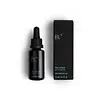What's inside
What's inside
 Key Ingredients
Key Ingredients

 Benefits
Benefits

 Concerns
Concerns

No concerns
 Ingredients Side-by-side
Ingredients Side-by-side

Sea Water
HumectantWater
Skin ConditioningGlycerin
HumectantPropanediol
SolventPentylene Glycol
Skin ConditioningAscorbyl Glucoside
AntioxidantSodium Hyaluronate
HumectantSodium Levulinate
Skin ConditioningSodium Anisate
AntimicrobialSodium Hydroxide
BufferingLecithin
EmollientBiosaccharide Gum-1
HumectantAlgae Extract
EmollientSilica
AbrasiveGlyceryl Caprylate
EmollientCitric Acid
BufferingTocopherol
AntioxidantWater
Skin ConditioningGlycerin 14.5%
HumectantDiethoxyethyl Succinate
Solvent1,2-Hexanediol
Skin ConditioningPanthenol
Skin ConditioningPolyglutamic Acid
Skin ConditioningPanax Ginseng Root Extract
EmollientSodium PCA
HumectantXylitylglucoside
HumectantAnhydroxylitol
HumectantXylitol
HumectantHydrolyzed Hyaluronic Acid
HumectantArginine
MaskingMethionine
Skin ConditioningCysteine
AntioxidantSodium Hyaluronate
HumectantHyaluronic Acid
HumectantHouttuynia Cordata Extract
Skin ConditioningTremella Fuciformis Extract
HumectantSodium Hyaluronate Crosspolymer
HumectantBeta-Glucan
Skin ConditioningHydrolyzed Sodium Hyaluronate
Skin ConditioningAdansonia Digitata Seed Extract
Skin ConditioningSophora Angustifolia Root Extract
Skin ConditioningMalus Domestica Fruit Extract
AntioxidantPunica Granatum Fruit Extract
AntioxidantPrunus Serotina Fruit Extract
MaskingVaccinium Macrocarpon Fruit Extract
AstringentButylene Glycol
HumectantPortulaca Oleracea Extract
Skin ConditioningCitrullus Lanatus Fruit Extract
Skin ConditioningGardenia Florida Fruit Extract
Skin ConditioningDextrin
AbsorbentDipotassium Glycyrrhizate
HumectantGlucose
HumectantSodium Polyacryloyldimethyl Taurate
Emulsion StabilisingSodium Polyacrylate
AbsorbentAcrylates/C10-30 Alkyl Acrylate Crosspolymer
Emulsion StabilisingPentylene Glycol
Skin ConditioningCarbomer
Emulsion StabilisingEthylhexylglycerin
Skin ConditioningCaprylyl Glycol
EmollientWater, Glycerin 14.5%, Diethoxyethyl Succinate, 1,2-Hexanediol, Panthenol, Polyglutamic Acid, Panax Ginseng Root Extract, Sodium PCA, Xylitylglucoside, Anhydroxylitol, Xylitol, Hydrolyzed Hyaluronic Acid, Arginine, Methionine, Cysteine, Sodium Hyaluronate, Hyaluronic Acid, Houttuynia Cordata Extract, Tremella Fuciformis Extract, Sodium Hyaluronate Crosspolymer, Beta-Glucan, Hydrolyzed Sodium Hyaluronate, Adansonia Digitata Seed Extract, Sophora Angustifolia Root Extract, Malus Domestica Fruit Extract, Punica Granatum Fruit Extract, Prunus Serotina Fruit Extract, Vaccinium Macrocarpon Fruit Extract, Butylene Glycol, Portulaca Oleracea Extract, Citrullus Lanatus Fruit Extract, Gardenia Florida Fruit Extract, Dextrin, Dipotassium Glycyrrhizate, Glucose, Sodium Polyacryloyldimethyl Taurate, Sodium Polyacrylate, Acrylates/C10-30 Alkyl Acrylate Crosspolymer, Pentylene Glycol, Carbomer, Ethylhexylglycerin, Caprylyl Glycol
Ingredients Explained
These ingredients are found in both products.
Ingredients higher up in an ingredient list are typically present in a larger amount.
Glycerin is already naturally found in your skin. It helps moisturize and protect your skin.
A study from 2016 found glycerin to be more effective as a humectant than AHAs and hyaluronic acid.
As a humectant, it helps the skin stay hydrated by pulling moisture to your skin. The low molecular weight of glycerin allows it to pull moisture into the deeper layers of your skin.
Hydrated skin improves your skin barrier; Your skin barrier helps protect against irritants and bacteria.
Glycerin has also been found to have antimicrobial and antiviral properties. Due to these properties, glycerin is often used in wound and burn treatments.
In cosmetics, glycerin is usually derived from plants such as soybean or palm. However, it can also be sourced from animals, such as tallow or animal fat.
This ingredient is organic, colorless, odorless, and non-toxic.
Glycerin is the name for this ingredient in American English. British English uses Glycerol/Glycerine.
Learn more about GlycerinPentylene glycol is typically used within a product to thicken it. It also adds a smooth, soft, and moisturizing feel to the product. It is naturally found in plants such as sugar beets.
The hydrophilic trait of Pentylene Glycol makes it a humectant. As a humectant, Pentylene Glycol helps draw moisture from the air to your skin. This can help keep your skin hydrated.
This property also makes Pentylene Glycol a great texture enhancer. It can also help thicken or stabilize a product.
Pentylene Glycol also acts as a mild preservative and helps to keep a product microbe-free.
Some people may experience mild eye and skin irritation from Pentylene Glycol. We always recommend speaking with a professional about using this ingredient in your routine.
Pentylene Glycol has a low molecular weight and is part of the 1,2-glycol family.
Learn more about Pentylene GlycolSodium Hyaluronate is hyaluronic acid's salt form. It is commonly derived from the sodium salt of hyaluronic acid.
Like hyaluronic acid, it is great at holding water and acts as a humectant. This makes it a great skin hydrating ingredient.
Sodium Hyaluronate is naturally occurring in our bodies and is mostly found in eye fluid and joints.
These are some other common types of Hyaluronic Acid:
Learn more about Sodium HyaluronateWater. It's the most common cosmetic ingredient of all. You'll usually see it at the top of ingredient lists, meaning that it makes up the largest part of the product.
So why is it so popular? Water most often acts as a solvent - this means that it helps dissolve other ingredients into the formulation.
You'll also recognize water as that liquid we all need to stay alive. If you see this, drink a glass of water. Stay hydrated!
Learn more about Water